Paradoxically a one-off event, which ought to liberate it somewhat from the weight of expectations, the Dallas Biennale presents a fresh and stimulating cross-section of new art. It suggests that the sponsoring Dallas Contemporary, which in true hometown think-big fashion bills itself as “America’s Kunsthalle,” has the potential to be a kind of P.S. 1 for the city: fast-moving, improvisational and daring, if occasionally a bit rough around the edges. Happily, as curator Florence Ostende explains in her introductory essay, the show disclaims any attempt at an overarching theme (such themes inevitably feel forced anyway). Nevertheless, it is possible to identify a couple of striking continuities among the works of several different artists. One is an interest in theatricality, in which viewers and objects are staged as characters in a drama (or comedy). Another is a concern with philosophy in a vernacular idiom, in which deep questions from big thinkers are raised in a casual, populist way.
As a largely out-of-town project, the Biennale has the value and the handicap of approaching its site with a fresh set of eyes. Someone who didn’t know any better might accuse some of the artists of making use of stereotypes about Dallas—football, car culture, country music, and narcissistic glamour obsession, among others, all make their appearance—but stereotypes can often be enlightening, and so it is here. Ostende’s essay cites the inspiration of several submerged episodes in Dallas exhibition history (i.e. the 1936 Texas Centennial Exposition, and Robert Smithson’s 1966 project for DFW Airport) whose relevance remains somewhat implicit, except perhaps for Sylvie Fleury’s Neiman-Marcus window installation, following in the footsteps of Stanley Marcus’s 1948 Gauguin exhibition in the same place.
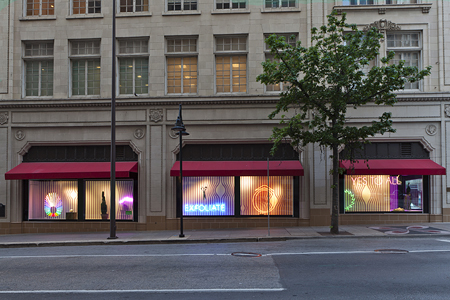
The scavenger-hunt nature of the twelve separate exhibition sites, half in the design district and half elsewhere, reward intrepid art lovers with a real sense of achievement on discovering each new venue. The downside, of course, might be a smaller audience. Visiting the sites after opening weekend, I didn’t encounter a single other viewer; presumably all other interested parties attended the opening and saw everything then. With today’s smartphone technology, such a project cries out for a downloadable app that could automate the process of navigating among the sites, and allow for various marketing and social-networking tie-ins at the same time, i.e.: “For the next exhibit, turn left on Main Street, drive two blocks, stop at the curb for Sylvie Fleury’s window display at Neiman Marcus, then continue two more blocks east for an espresso at the Mercantile Coffee House, where one of your friends is Mayor on Foursquare. Do you want to Tweet this?”
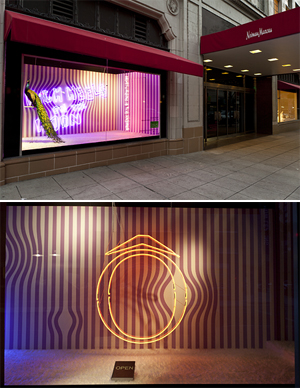
Each exhibition site was marked with a small sign bearing the Biennale logo, colored in a reverse-tricolor blue-white-red pattern resembling the French flag, That might be an acknowledgement of Franco-American friendship, of the French background of the Biennale’s curator and several of its artists, of the Fourierist commune of La Réunion and its place in Dallas history, the role of UT Dallas in establishing FRAME, the French Regional American Museum Exchange, or perhaps nothing at all. In fact, the best-represented art scenes in the exhibition were those of France and Houston (Michael Corris was the sole Dallas representative), suggesting a kind of Franco-Houstonian axis in the spirit of Dominique de Menil. Four of the Houston number, more precisely, are resident Core Fellows at the Glassell School of Art there (Australian Anthea Behm, Brazilian Clarissa Tossin, and Americans Nicole Miller and Gabriel Martinez), about which one might draw either positive or negative conclusions. On the one hand, good for Houston in bringing in so many strong foreign talents; on the other hand, does Dallas measure up in that respect? Back on the first hand, does the preponderance of guest residents reflect badly on the local scene; returning to the other hand again, does it rather reflect a disregard for the local scene? I wouldn’t attempt to answer. I am tempted to see the French connection as one possible source for the presence of philosophical discourse in this Biennale. In the land of Descartes and the baccalauréat, every college-bound student studies the subject, making it a kind of lingua franca there as perhaps nowhere else. In this Biennale, Theodor Adorno’s aesthetic theory is delivered in the manner of Ferris Bueller (by AntheaBehm), a manga character named Annlee recites a text on game theory by MedhiBelhajKacem (via Pierre Joseph), and Robert Smithson’s theories of art expressed as a bouncy country tune (from Mario Garcia Torres).
As for the background of the exhibition’s artists, is it possible to identify commonalities with any specificity? One tendency, represented by Pierre Joseph, is the kind of provisional interactivity that has become known, through the efforts of curator Nicolas Bourriaud, as “relational aesthetics,”widely known in the work of such artists as Dominique Gonzalez-Foerster, Philippe Parreno and Pierre Huyghe. Fans of the seminal project No Ghost Just a Shell, in which Parreno and Huyghe acquired the rights to a manga character named Annlee and commissioned other artists to use her in their artworks, will be happy to see Annlee make an appearance in the Biennale, in Joseph’s video Trickster Theory, declaiming philosophically about video games. Joseph’s Characters to be reactivated is a set of characters (such as, naturally, a football player and a cowboy) instantiated here by costumes hanging on a rack and in one case worn by an obliging actor. When I visited, the actor was wearing the cowboy costume and lay motionless on the floor for the duration. In Joseph’s Hide and Seek, three props—a pair of Air Jordans, a mobile phone and a knife—are placed suggestively on a magic carpet.
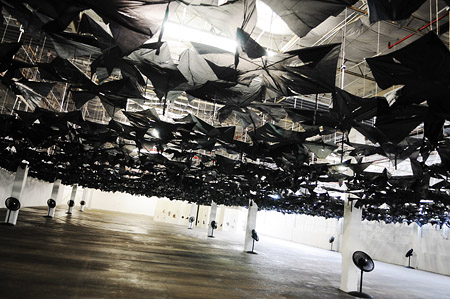
Claude Lévêque, whose theatrical work is installed at the Dallas Contemporary, could also be seen as a cousin of this school. The right-hand gallery at the Contemporary is filled with Lévêque’s Dying Swan, whose title recalls Anna Pavlova’s tragic ballet, where a ceiling full of torn umbrellas and a discarded long black dress stand for the doomed swan/ballerina. Outside in a small cottage is Lévêque’s Le droit du plus fort (The Right of the Strongest), where car mufflers dance from the ceiling to the accompaniment of flashing strobe lights and Yngwie Malmsteen-esque lead-guitar pyrotechnics. Although opposite in emotional tone, Lévêque’s two pieces share a basic theatricality.
Hugues Reip’s work is also quite theatrical, in a fairy-tale kind of way, installed at 1335 Levee Street. Mushbook (Dallas Version) has paper mushrooms pushing up from the pages of William S. Burroughs’s book Nova Express, while The Forest is an arrangement of artificial plants cast in shadow on the floor of a loading dock. The Storm is a film in which three layers of scenery pass by in B-movie fashion as “storm sounds” play—a tribute to the homemade, amateur imagination. The centerpiece is White Spirit (Black Soul), a rotating carousel of cutout ghost shapes that cast their shadows on the wall as they move past.

Another tendency is the strain of crisp, punchy text-and-design conceptual art that coalesced in the 1980s and is now world-famous (NewYork, Tucson, Geneva, New Zealand), here represented by Michael Corris and Sylvie Fleury, but which also includes John Armleder and Olivier Mosset. Fleury’s installation in the Neiman Marcus windows surrounded bits of text (“EXFOLIATE”; “YES TO ALL”; “HIGH HEELS ON THE MOON”) with undulating striped backdrops. Corris’s work, at the 129 Leslie Street event space, included Twelve Rules from the Collection of the Artist (“5. No wristbands. The artist is already shackled.”) Both artists demonstrate just how much of a text’s meaning actually comes from the extra-textual elements of visual form and context.
Corris’s work hangs next door to a photograph and videos by Michael Smith from a project entitled Excuse Me I am looking for the Fountain of Youth, inspired by a trip to St. Augustine, Florida, home of the mythical fountain, in which Smith comes to terms with growing old while confronted with that emblem of eternal youth, a rock band. Like Fleury, Charlotte Moth looks for a metaphorical dimension in interior design. At the Goss-Michael Foundation, Moth has a curtain behind which are projected photographs of a fig tree in a courtyard. Moth (a resident this spring at Fieldwork: Marfa and hence perhaps already an honorary Texan) sets up the interior gallery as a stage, and visitors as an audience.

It was a smart move to place two of the twelve exhibition sites in West Dallas, allowing visitors a chance to drive the Calatrava bridge and emerge on emphatically non-gentrified Singleton Boulevard. Nicole Miller’s Daggering, a video projection on two screens, is in a sweltering warehouse at 2900 Bataan Street, in a space still raw enough to retain a “PURO WEST SIDE” graffiti tag on one interior wall. Projected on one screen is a video of young people at a party “daggering,” defined by music journalist David Katz as “a super-lewd ‘dance’ that leaves little to the imagination, in which groin-locked couples enact rapid-speed dry-humping” and which prompted a symbolic ban by the Jamaican Broadcasting Commission. On the other screen is a first-person narrative with voiceover about the artist’s conflicted relationship with the Eurocentric culture of ballet. The video obviously contrasts two kinds of dance as representatives of two kinds of culture, but Miller is interested in the visual rhetoric of musical performance more broadly; her 2009 video The Conductor explored the tics and tropes of the concert-hall maestro. Houston-based Miller studied at University of Southern California, an insurgent program challenging the L.A. art-school hegemony of Cal Arts and UCLA, whose MFA alumni have produced some sharp work recently seen around Texas (Ry Rocklen and Amanda Ross-Ho at the UTVAC in Austin; Rocklen’s sculpture was a hit at the Thomas Solomon Gallery’s Art Fair booth).
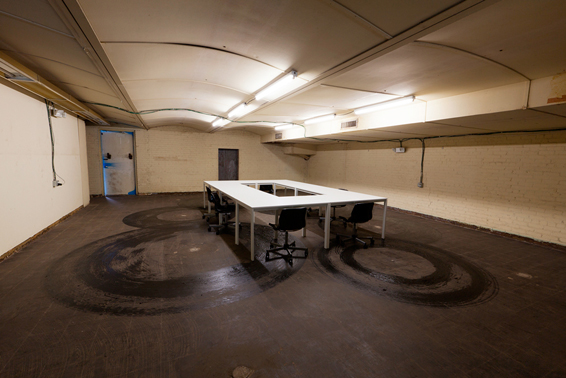
Around the corner on Singleton, in an empty office building recently home to the acclaimed Sustenance exhibition, is a series of pieces by Delphine Reist in adjoining rooms on two floors: A set of air horns on lunch coolers emit deafening one-note blasts. A storage rack full of spray-foam canisters sits next to Pollock-style streamers of the expelled foam. A row of paint rollers is poised in the midst of applying a Daniel Buren stripe job to the wall. A group of rolling office chairs sit atop Orozco-style circles of black paint on the floor. My favorite, in an enclosed space, a swarm of motorized Roomba-type floor buffers is set loose to wax the floor in the madcap fashion of Reist’s fellow Swiss kineticist Jean Tinguely. Finally, in a darkened room, a video plays showing a silhouette of racetrack-style crossed flags.
The slick design showroom at 150 Turtle Creek Boulevard, showcasing the work of six rising young artists, including the four Glassell Core Fellows, is the centerpiece of the Biennale, and an aesthetic shock after the chic grunge of the ramshackle West Dallasbuildings. Among the more illustrious artists in the whole show is the roving bard of the conceptual-art tradition, a man who does more with less than just about any other artist: Mario Garcia Torres, whose work is to transform the somewhat arid history of critical neo-avant-garde art into a rollicking picaresque adventure orchestrated by himself. Whether tracking down obscure, doomed projects by European conceptualists for Greek and Caribbeanvacation resorts or enacting imagined episodes in the lives of site-specific artworks, Garcia Torres articulates a world of fantasy in the language of readymades and institutional critique. For the Biennale, Garcia Torres, backed by a band of Dallasmusic notables (including Salim Nourallah), contributes a country song (co–written & produced by local singer/songwriter J.D. Whittenburg) in tribute to Robert Smithson, who died young. Days later, the extremely catchy chorus remains in my head: “Some days you make the work, and other days the work makes you / Hard to know which one is true…”
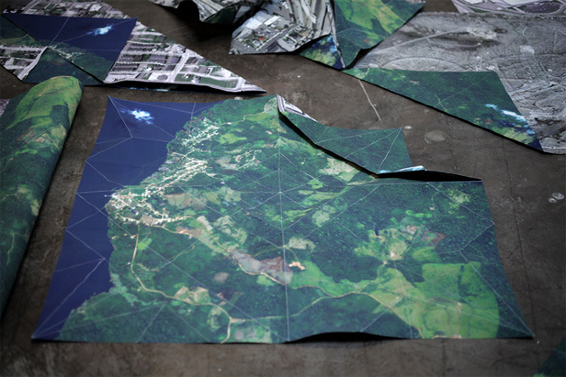
The other artists in the Turtle Creek showroom are arranged in adjoining galleries. Galveston-based Nick Barbee shows portrait series in clay and on paper, with a particular focus on racial struggles in American history. He supplies costume elements, such as Braids for Pocahontas, A Beard for Nat Turner or A Tie for Marion Barry.There are also books, i.e., 12 Portraits of William Tecumseh Sherman, 72 Portraits of Arthur Ashe, and 60 Portraits of John Brown.Clarissa Tossin, perhaps inspired by her recent stay in the energy capital of Houston, explores the connections between car culture, megalomania and natural resource-extractive industries. Derived from her research of Henry Ford’s failed Amazonian rubber plantation Fordlandia, she presents a set of folded satellite survey maps on the floor, with Fordlandia on one side and U.S. car cities (Dallas, Detroit, etc.) on the other. As long as I’m driving consists of maxims painted on the parking lot of the Contemporary for recitation by car-bound viewers, i.e. “As long as I’m driving, I’m consuming.” In a piece of didactic philosophical reflection, Anthea Behm’s video Adorno/Buellerhas actors in museum garb face the camera and recite particularly rigorous passages from Theodor Adorno’s Aesthetic Theory, set within the Art Institute of Chicago in the manner of Ferris Bueller’s Day Off. Gabriel Martinez, in a Rauschenbergian gesture, has subleased his exhibition real estate to four other artists: Miguel Amat, Per Billgren, Massa Lemu and Ledelle Moe, all from the developing world and all addressing “issues of labor, immigration and citizenship,” according to the brochure. (To be precise, then, there are ten artists altogether in the Turtle Creek showroom, and Amat is also a Core fellow, so that makes five such Fellows.)

The works of Zoe Crosher and Morehshin Allahyari make for an interesting contrast in terms of self-representation. A selection from Crosher’s project on Michelle DuBois is on view at the Contemporary. The premise is that DuBois, a globe-trotting call girl of the 1980s, bequeathed to Crosher a personal photographic archive recording her many theatrical exploits (here, for example, dressing up as Mae West), which in turn serves as the basis for Crosher’s own image and text generation. (Another segment of the DuBois project was also recently a hit here at the art fair.) Among the many offspring of Andy Warhol and Cindy Sherman, Crosher is indisputably among the most intelligent and ambitious. For Allahyari’s Romantic Self-Exiles, on view at Oliver Francis Gallery, the artist projects videos taken from the Tehran cityscape around the gallery walls, across an arrangement of transparent Plexiglas boxes that resemble a skyline, expressing one’s longing for an absent, beloved place. It’s hard not to think that Allahyari’s self-presentation is more serious and inspiring than Crosher’s, but both projects are credible and engaging.
Although it’s too bad that there won’t be more such Dallas Biennales, the precedent is set. I would suggest that an excellent follow-up to this Franco-Houstonian exhibition would be for a 2014 Biennale in our sister city of Dijon, featuring a selection of Dallas artists and organized by local curatorial talent such as that behind DB12 or The Art Foundation. That would be a fitting riposte to this non-biennial biennale’s stimulating and energetic effort.
Photo at top: Delphine Reist, Storage, 2012. Shelves, foam, various materials. All photos by Kevin Todora, courtesy Dallas Biennale, Dallas Contemporary, unless where noted. For Todora’s reaction to the Daphine Reist installation, go here.




